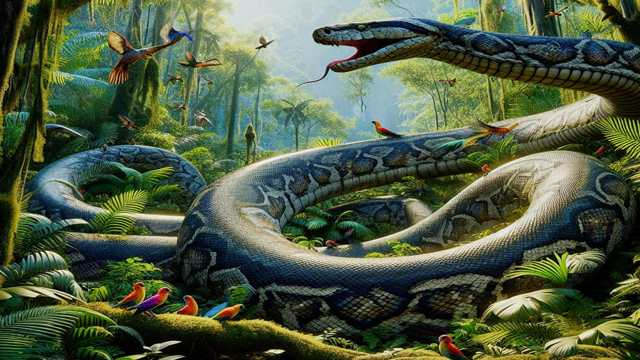A Discovery published in the journal Nature has revealed the existence of the largest snake the world has ever known, a creature as long as a school bus and as heavy as a small car. This colossal snake, named Titanoboa, ruled tropical ecosystems just 6 million years after the extinction of the fearsome Tyrannosaurus Rex.
Discovery of Titanoboa
Partial skeletons of Titanoboa, a new giant boa constrictor-like snake, were found in Colombia by an international team of scientists. These fossils are now housed at the University of Florida. Jonathan Bloch, a vertebrate paleontologist at UF, co-led the expedition with Carlos Jaramillo, a paleobotanist from the Smithsonian Tropical Research Institute in Panama. Researchers estimate Titanoboa to be 42 to 45 feet long, comparable in length to the T-Rex “Sue” displayed at Chicago’s Field Museum.
A Snake Beyond Imagination
The discovery of Titanoboa has surpassed the wildest dreams of modern horror filmmakers. Jonathan Bloch, who is studying the snake at the Florida Museum of Natural History, remarked, “The snake that tried to eat Jennifer Lopez in the movie ‘Anaconda’ is not as big as the one we found.” Jason Head, a paleontologist at the University of Toronto in Mississauga and the paper’s senior author, added, “The snake’s body was so wide that if it were moving down the hall and decided to come into my office to eat me, it would literally have to squeeze through the door.”

Titanoboa’s Size and Its Implications
Titanoboa tipped the scales at an estimated 1.25 tons and lived during the Paleocene Epoch, a 10-million-year period immediately following the extinction of the dinosaurs 65 million years ago. The scientists also discovered skeletons of giant turtles and extinct primitive crocodile relatives that were likely prey for Titanoboa.
Prior to this work, there had been no fossil vertebrates found between 65 million and 55 million years ago in tropical South America, leaving scientists with a limited understanding of life in the northern Neotropics. Bloch explained, “Now we have a window into the time just after the dinosaurs went extinct and can actually see what the animals replacing them were like.”
Climate and Environment Insights
The enormous size of Titanoboa is a sign that temperatures along the equator were once much hotter. Cold-blooded animals like snakes are limited in body size by the ambient temperature of their environment. Bloch noted, “If you look at cold-blooded animals and their distribution on the planet today, the large ones are in the tropics, where it’s hottest, and they become smaller the farther away they are from the equator.”
Based on the snake’s size, the team calculated that the mean annual temperature in equatorial South America 60 million years ago was about 91 degrees Fahrenheit, roughly 10 degrees warmer than today. The presence of such outsized snakes and turtles indicates that even 60 million years ago, the foundations of the modern Amazonian tropical ecosystem were already in place.
The Discovery Process
Fossil hunting in the forest-covered tropics is typically challenging due to the lack of exposed rock. However, excavations in the Cerrejon Coal Mine in Northern Colombia exposed the rock and offered an unparalleled opportunity for discovery. After the team brought the fossils to the Florida Museum of Natural History, UF graduate students Alex Hastings and Jason Bourque first recognized they belonged to a giant snake.
Jason Head, an expert on fossil snakes, worked with David Polly, a paleontologist at the University of Indiana, to estimate the snake’s length and mass. They determined the relationship between body size and vertebral size in living snakes and used that relationship to figure out the body size of the fossil snake based on its vertebrae.
Significance of the Discovery
Harry W. Greene, a professor in the department of ecology and evolutionary biology at Cornell University and one of the world’s leading snake experts, emphasized the importance of this discovery. He stated, “The giant Colombian snake is a truly exciting discovery. For decades herpetologists have argued about just how big snakes can get, with debatable estimates of the max somewhat less than 40 feet.”
Conclusion
The discovery of Titanoboa provides valuable insights into the ancient tropical ecosystems and the climate conditions of the Paleocene Epoch. This enormous snake not only captures the imagination but also helps scientists understand the evolutionary history of reptiles and their adaptation to changing environments. The find underscores the importance of continued exploration and study of the fossil record to uncover the mysteries of Earth’s past.